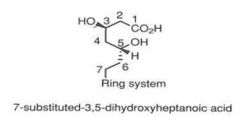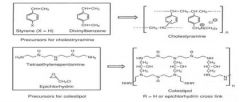![]()
![]()
![]()
Use LEFT and RIGHT arrow keys to navigate between flashcards;
Use UP and DOWN arrow keys to flip the card;
H to show hint;
A reads text to speech;
22 Cards in this Set
- Front
- Back
|
1. Describe the effects of HMG-CoA inhibitors and explain how this leads to an overall decrease in plasma LDL concentration.
|
Lower plasma cholesterol by 2 mechanisms
1.Inhibition of cholesterol biosynthesis 2.Enhancement of LDL update by the liver. (cuased by an increase in LDL receptors |
|
|
2. Given the structure of a statin drug, identify the structural feature that is absolutely necessary in order for these agents to inhibit HMG-CoA reductase.
|

The 3,5 dihydroxycarboxylate is essential for inhibition.,
|
|
|
3. Describe the molecule that statins mimic, which makes them effective inhibitors of HMG-CoA reductase.
|
They mimic the tetrahedral intermediate generated in teh conversion of HMG CoA to mevalonic acid.
|
|
|
Describe the common adverse effects with Statins
|
Disturbed liver function (liver function should be monitored)
Myalgia and Rhabdomyolisis (muscle necrosis followed by renal failure) - Creatinine phosphokinase (CPK) should be monitored for the first few months. |
|
|
Identify the essential structural feature in the fibrates for activity
|

Isobuteric acid group, if an ester drug – it has to be hydrolysezed
|
|
|
What does a nictinic acid look like?
|

|
|
|
What does do fibrates look like?
|

|
|
|
What do natural statins look like?
|

|
|
|
What do synthetic statins look like?
|

|
|
|
What do bile acid sequesterants look like?
|

|
|
|
Provide a metabolism based reason to explain why CYP3A4 mediated drug-drug interactions are less of a concern with fibrates compared to statins.
|
Firbrates can be metabolized by different pathways – less potential for drug interactions.
|
|
|
Describe metabolism (dose-dependent)
|
Large dose (used in hyperlipoproteinemia = metabolism is different than small dose (dietary supplement)
|
|
|
MOA of nicotinic acid
|
inhibits lipolysis in adipose tissue and increases HDL level
|
|
|
What are the common adverse effects of nicotinic acid
|
Perhipheral vasodialation
GI effects Hepatic dysfunction Elevates glucose and uric acid levels (use with caution in diabetes and gout.) |
|
|
Describe the mechanism of action of the bile acid sequestrants (this should involve a description of structure
|
Indirection lower plasma LDL levels by removing bile acids from the GI tract. Decrease in bile acids returning to the liver causes more cholesterol to be converted to bile acids. Decrease in hepatic cholesterol causes increase in LDL receptor expression and results in increased hepatic uptake of LDL
|
|
|
Provide a structural reason to explain why the bile acid sequestrants are eliminated in the feces.
|
They are not orally absorbed, and excreted as insoluble complexes with bile acids.
|
|
|
Describe the mechanism of action of ezetimibe.
|
Inhibits absorption of cholesterol in the brush boarder membrane in the intestinal lumen, resulting in a lowering of plasma cholesterol. (may bind to a specific transport protein)
|
|
|
Describe the metabolism of ezeimibe.
|
Metabolized in the intestinal wall to its active metabolite, Phenol Glucuronide. Less than 5% oxidized to a ketone – no significant effect on CYP 450.
|
|
|
Describe the SAR of ezeimibe.
|
OH groups are important in localizing the compound in the intestine; the p-fluoro groups block undesirable metabolism.
|
|
|
What are some of the adverse reactions of Fibrates?
|
GI disturbance (most common)
Can cause myopathy and increase liver enzymes present in the plasma. |
|
|
What is the DI of bile acid sequesterants?
|
They can bind with and decrease absorption of almost any other drug, especially acidic drugs and diatary supplemments
|
|
|
What are the side effects of Bile acid sequesterants?
|
Constipation, bloating, bowel obstruction, bleeding
|

